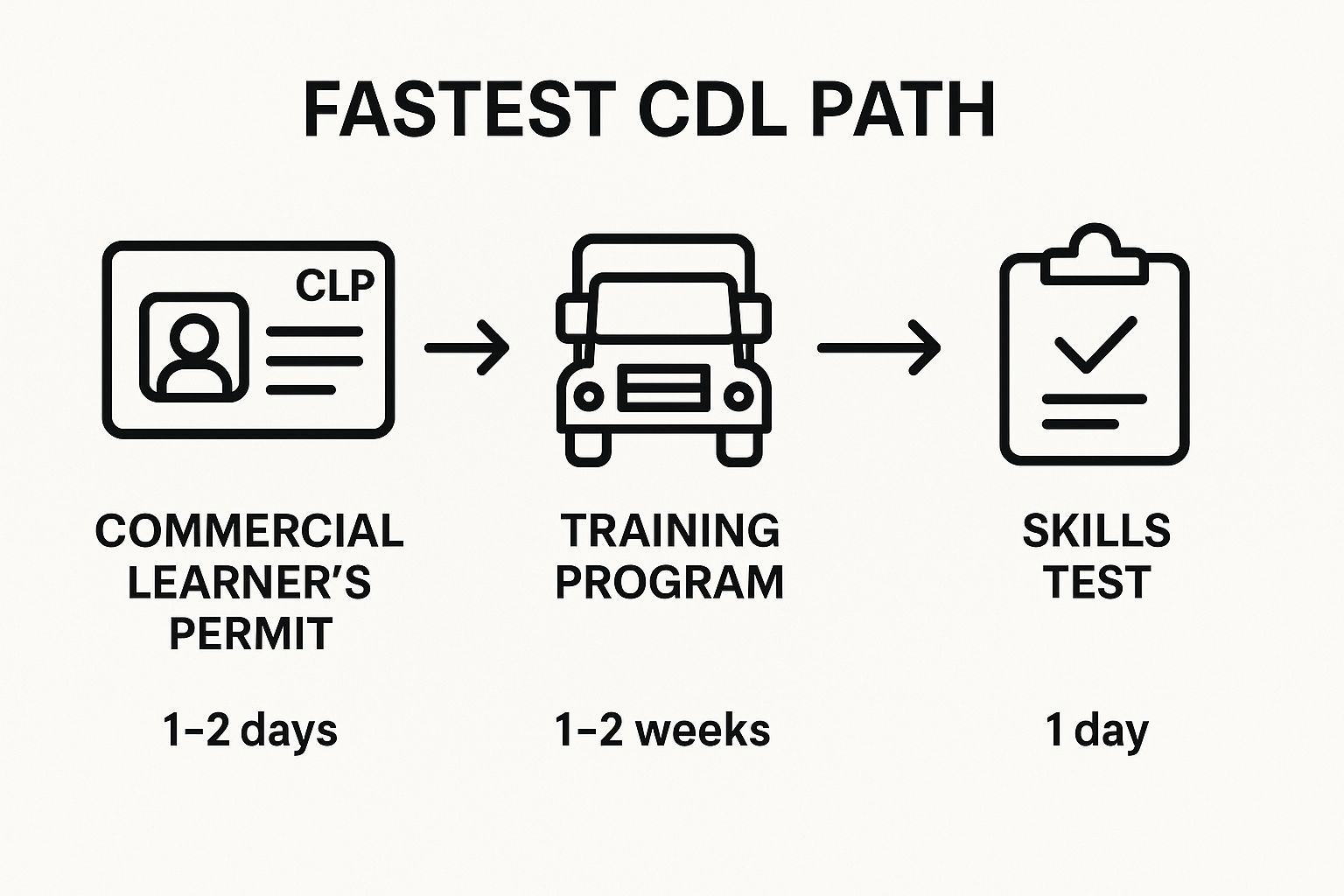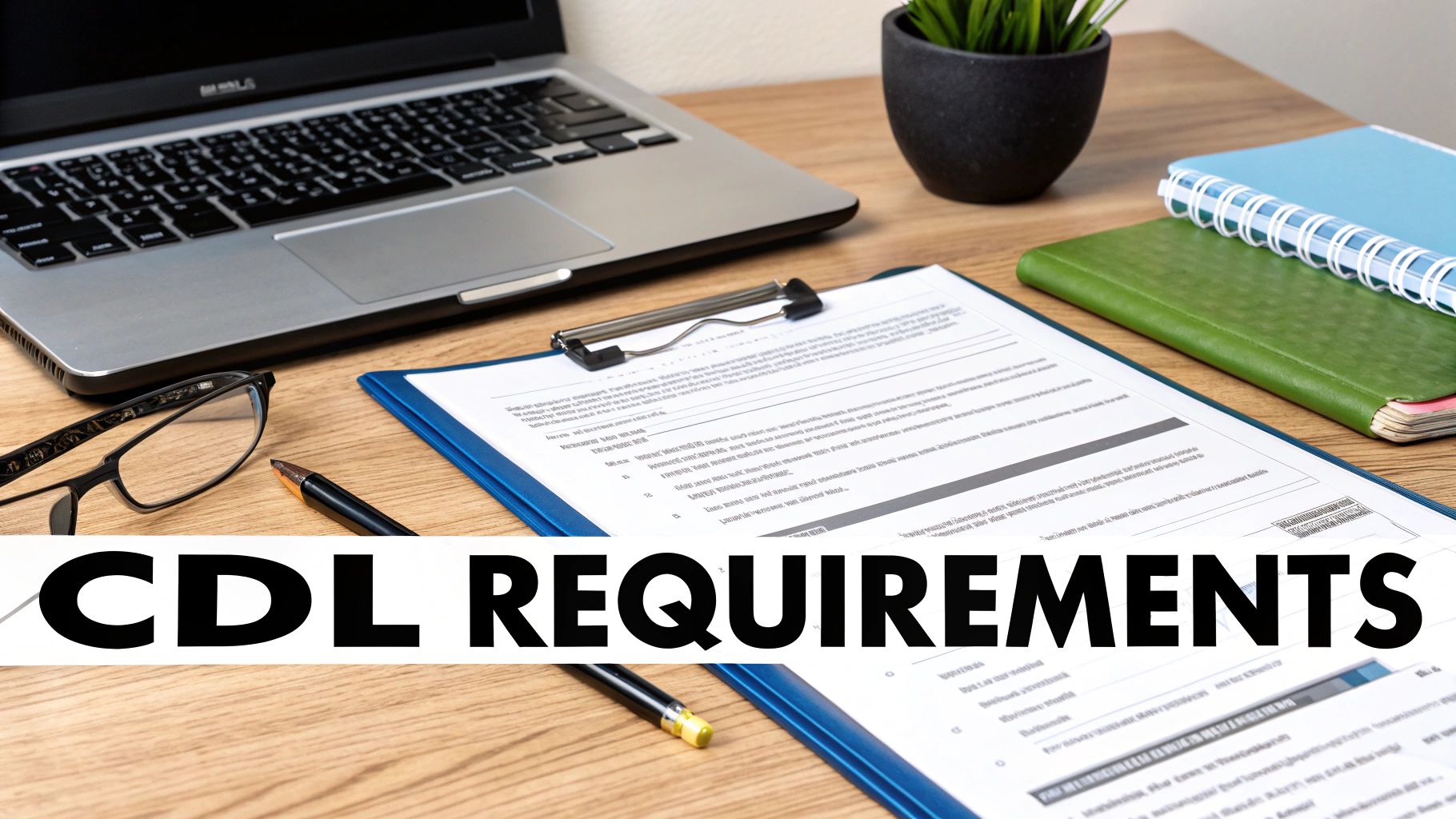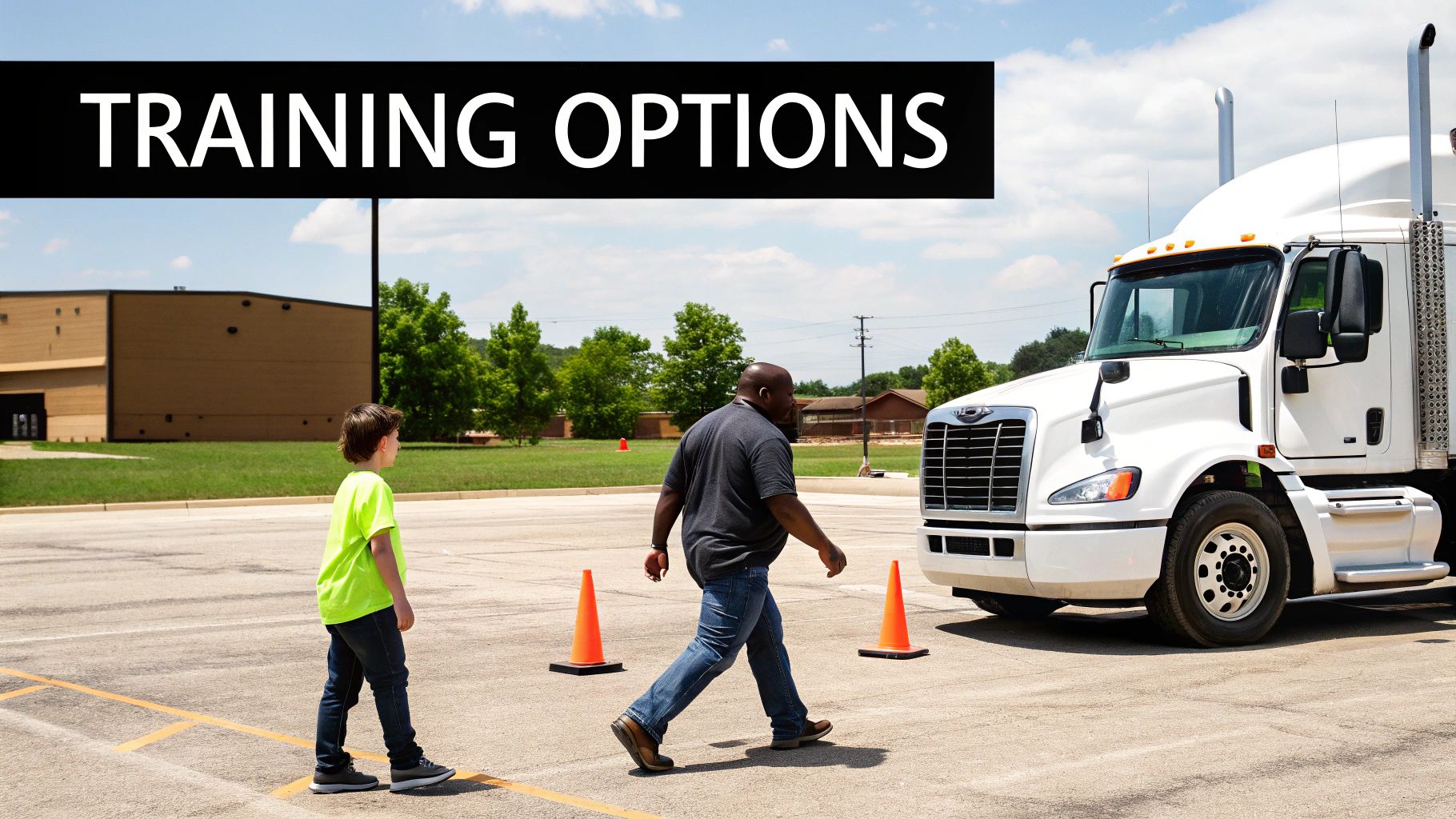If you want to get your Commercial Driver's License (CDL) fast, there's one surefire way to do it: enroll in a full-time, accelerated truck driving school. These are intense, immersive programs that cram months of training into just a few weeks. They’re designed to be the most direct path to a new career, but your success really depends on the prep work you do before you ever show up. Arriving with your permit and all the right paperwork in hand is the name of the game.
Your Fast Track to a Commercial Driver's License
Getting your CDL quickly isn't about cutting corners—it’s about being smart and efficient. The single best way to do this is through a full-time, accelerated training program. Forget about part-time courses that drag on for months. These intensive classes are built for one thing: getting you licensed and on the road as fast as humanly possible.
Typically, these programs run Monday through Friday and demand your complete focus for several weeks. It's a whirlwind. You’ll go from classroom theory to hands-on yard maneuvers and then to real-world driving in a very short amount of time. This focused environment is how you build skills so rapidly. For a detailed breakdown of what you'll need, you can review the specific CDL requirements you'll have to meet.
Get the Paperwork Done First—It’s Crucial
Before you can even think about climbing into the cab, you've got to knock out the administrative hurdles. Here’s the single biggest time-saver: get your Commercial Learner's Permit (CLP) before your program starts. When you walk in on day one with your CLP, you can jump straight into the hands-on training, which can shave a ton of time off your schedule.
You’ll also need to pass a Department of Transportation (DOT) physical and have all your essential documents ready to go. You'll almost certainly need:
- A valid driver's license
- Proof of U.S. citizenship or lawful permanent residency
- Your Social Security card
- A certified copy of your driving record
Pro Tip: Having all your documents and your CLP ready before day one is the most important thing you can do. It cuts out the bureaucratic headaches and lets you dive right into what you’re there for—learning to drive.
To give you a clearer picture, I've put together a typical timeline for how these accelerated programs work.
Typical Accelerated CDL Program Timeline
This table breaks down the key phases and how long you can expect each one to take. It shows just how quickly you can move through the process if you’re prepared.
| Phase | Typical Duration | Key Activities |
|---|---|---|
| Pre-Training Preparation | 1-2 weeks | Studying for the CLP, passing the written tests, getting a DOT physical. |
| Classroom & Permit | 1 week | In-depth theory, systems knowledge, and final prep for any remaining permit tests. |
| Yard & Range Training | 1-2 weeks | Mastering pre-trip inspections, backing maneuvers, and coupling/uncoupling. |
| On-Road Driving | 1-2 weeks | Driving in real traffic, shifting, turning, and handling various road conditions. |
| Final Test & Licensing | 1 day | Taking the official CDL skills test (pre-trip, backing, road test). |
As you can see, the timeline is tight. It’s all about hitting the ground running and maintaining momentum from start to finish.
This whole process can move incredibly fast when you're dedicated.

As this shows, it's absolutely possible for a focused student to go from getting their permit to passing their final skills test in just a few weeks. It's a sprint, not a marathon.
How to Choose the Right Accelerated CDL School

Finding the fastest way to get your CDL isn't just about speed; it's about picking a school that delivers real results. Your choice here is a big one—it sets the tone for your cost, your timeline, and your first job out of the gate. You have to look past the slick marketing and figure out what a new driver actually needs to succeed.
Your main choices are usually private schools, community colleges, or company-sponsored training. Private schools are typically the fastest, offering immersive, full-time programs that can get you licensed in just a few weeks. Company-sponsored programs are another quick option that can be cheap upfront, but you’ll be signing a work contract. Community colleges are often a more affordable, though sometimes slower, middle ground.
Vetting the School's Curriculum and Resources
The absolute core of any good CDL program is the balance between classroom theory and actual seat time. You need a school that gets you behind the wheel as much as possible. A program that keeps you stuck in a classroom for too long won't prepare you for the road or the skills test. Always ask for a detailed breakdown of the hours.
The quickest path to a CDL is a smart mix of classroom work and practical, hands-on driving. For example, some top-tier programs can get you a Class A CDL with an air brakes endorsement in 16 weeks or less by blending in-cab training, simulators, and even online modules for a truly efficient education.
Crucial Insight: I tell every aspiring driver this: shoot for a student-to-instructor ratio of 4:1 or better for the in-cab portion. If that number gets any higher, you’ll spend more time sitting in the passenger seat watching than you will driving, which completely misses the point of an accelerated course.
Don’t forget to check out the trucks. You want to train on modern, well-maintained equipment that’s similar to what you’ll be driving on the job. A yard full of old, beat-up rigs is a huge red flag that the school is probably cutting corners elsewhere, too.
Questions to Ask the Admissions Rep
When you get an admissions rep on the phone, your job is to get straight, solid answers. Don't be timid—this is a serious investment of your time and money. Here are the questions I always recommend asking:
- Instructor Experience: How many years of real-world, over-the-road experience do your instructors have? The best teachers are veteran drivers who've seen it all, not just someone who's good at passing the test.
- Job Placement Rate: What’s your verifiable job placement rate for recent graduates? Push them on this. Ask how they define "placement" and if they have a list of trucking companies that hire their grads.
- Total Cost: What is the real, all-in cost? Make sure their answer includes tuition, all fees, books, drug screenings, and every single test fee. Hidden costs are a budget killer.
A quality school will be upfront and have ready answers. Beyond the driving practice, remember you still have to nail the written exams. To get a leg up, take a look at our guide on how to ace the https://patriotcdl.com/general-knowledge-test/.
By digging into these details, you'll find a school that doesn't just promise a fast track to your CDL but actually delivers, setting you up for success from day one of your new career.
Mastering Your CDL Permit Written Exams

Everything starts with your Commercial Learner's Permit (CLP). If you want to get your CDL quickly, passing the written permit exams on your first try isn't just a goal—it's essential. Fail a test, and you're stuck with a mandatory waiting period, which can be up to 14 days in some states, before you can try again. That kind of delay completely torpedoes an accelerated timeline.
The smartest move you can make is to have these tests aced before you ever step foot in a truck. This requires dedicating some serious study time, but doing it upfront will pay off big time.
Your Strategic Study Plan
First things first: don't just grab your state's CDL manual and try to read it cover-to-cover. That's a classic rookie mistake. Those manuals are incredibly dense, often confusing, and a terribly inefficient way to study.
Instead, zero in on the only three sections you actually need to pass for a standard Class A CLP:
- General Knowledge: This is the big one. It's the longest and most comprehensive test, covering everything from vehicle control and safety regulations to basic driving principles.
- Air Brakes: You absolutely have to know air brake systems inside and out—how they work, how to inspect them, and how to use them safely. This is a non-negotiable safety exam.
- Combination Vehicles: This test is all about the unique physics of driving a tractor-trailer. You'll be tested on coupling and uncoupling, making wide turns, and handling the "crack-the-whip" effect.
Treat each of these as its own separate subject. By focusing your energy this way, you’re studying what actually gets you the pass.
I see it all the time—drivers underestimate the written exams. They fail, have to reschedule, and suddenly their training start date gets pushed back weeks. Passing these on the first shot is the single biggest thing you can do to keep your timeline on track.
The Most Effective Study Resources
Forget passive reading. The key to learning this material is active recall, and that means practice tests. Modern study tools are designed for this and are far more effective than just highlighting a manual.
You want resources that give you questions that feel just like the real exam. High-quality online platforms offer huge question banks that let you drill the material over and over. This does two things: it burns the information into your memory and gets you comfortable with the test format, which helps a ton with test-day nerves. For a deeper dive into the permit process, check out our guide on obtaining your commercial driver's permit.
So, when are you ready? Once you're consistently hitting 90% or higher on your practice tests, it's time to book your appointment at the DMV. Don't jump the gun. Walking in confident is the best way to walk out with your permit, ready for the next step: getting behind the wheel.
Passing the Behind-the-Wheel Skills Test
This is it—the final hurdle. Your hands-on skills test is where all the practice and study come together. If you're looking for the fastest way to get your CDL, passing this on your first try is non-negotiable. A failure here isn't just a bump in the road; it means a mandatory waiting period and the hassle of rescheduling, which can easily set you back weeks.
The exam isn't just one big driving test. It's actually a three-part evaluation, and you need to pass each section independently to earn that license. Let’s break down exactly what you need to do to impress the examiner and walk away with your CDL in hand.
The Three Pillars of the CDL Skills Test
Your examiner needs to see that you're a safe and competent driver, and the test is structured to verify just that. It's broken down into three distinct segments:
- Pre-Trip Inspection: This is where you prove you can systematically check the truck to ensure it's safe and ready for the road. It’s a memory-intensive test where you point out components and verbalize what you’re checking for.
- Basic Control Skills: This part is all about handling the rig in tight spaces. You'll be asked to perform a few low-speed maneuvers like straight-line backing, offset backing, or alley docking.
- On-Road Driving: The final piece of the puzzle. Here, the examiner will watch how you operate the truck in real-world traffic, assessing everything from your turning and lane control to your shifting and how well you follow traffic laws.
Of these three, the pre-trip inspection is where I see most students stumble. It’s a pure memorization game. To build a routine you can do in your sleep, our in-depth guide to the pre-trip inspection lays out a step-by-step process you can follow and master.
Nailing the Pre-Trip Inspection
The trick here isn't just to memorize a list of parts. You need to understand why you're checking each item. This context makes the information stick and helps you explain it clearly to the examiner. Develop a consistent pattern and never deviate from it—start at the front of the truck and work your way around clockwise, every single time.
Practice your inspection speech. Out loud. Over and over again, until it becomes second nature. Saying the words as you point to the parts builds powerful muscle memory. Your goal is to move with a quiet confidence, without hesitating or searching for words.
I can't stress this enough: The pre-trip is your first impression on the examiner. A clean, confident, and thorough inspection sets a professional tone for the entire test and shows you take safety seriously.
Mastering Basic Control and On-Road Driving
When it comes to the backing maneuvers, the key is to make small, slow adjustments. The most common mistake is over-steering, which gets you into trouble fast. Keep your eyes glued to your mirrors, and don't be afraid to get out and look if you're unsure of your position. You're allowed a certain number of "get out and looks" (GOALs), so use them!
During the on-road portion, your focus shifts to demonstrating total control and situational awareness. This means executing smooth shifts, keeping a safe following distance, and actively checking your mirrors every 5-8 seconds. It also helps to be vocal. Pointing out a potential hazard you see up ahead shows the examiner you’re thinking like a pro and scanning your environment.
Common Automatic Fails to Avoid
Some mistakes are so serious they will end your test on the spot. Avoiding these is absolutely critical.
| Mistake Category | Specific Examples |
|---|---|
| Traffic Law Violation | Running a red light, speeding, or failing to yield right-of-way. |
| Unsafe Action | Causing an accident or forcing another vehicle to take evasive action. |
| Lack of Control | Hitting a curb during a turn or striking a cone during maneuvers. |
By focusing on these key areas, you'll build the muscle memory and confidence needed to pass your skills test the first time around, keeping your journey to a new career firmly on the fast track.
Considering Company Sponsored CDL Training

While paying for a private school is a direct route to getting your CDL, there's another path that a lot of new drivers take: company-sponsored training. If the upfront cost of tuition is your main hurdle, this can look incredibly appealing. The concept is simple: a trucking company covers your training costs, essentially handing you a "free" CDL in exchange for your commitment to drive for them.
This can absolutely be one of the quickest ways to get licensed and start earning a paycheck, but it's a path with some serious trade-offs. You aren't just a student in their eyes; you're a future employee from the moment you apply. Be prepared for a much more intense application and screening process before you’re even accepted into the program.
The Contractual Commitment
The single biggest thing to wrap your head around is the contract. When a company sinks thousands of dollars into your training, they need to get a return on that investment. This almost always means signing a contract to work for them for at least one year, sometimes even longer.
If you decide to leave before that contract is up, you'll face a steep financial penalty. Most agreements state you’ll have to repay the entire cost of the training, which can easily be several thousand dollars. It is absolutely critical to read every single line of that contract before you put your name on it. Make sure you understand exactly what you’re committing to.
The contract is the heart of the deal. You’re trading your time and loyalty for a paid-for education. It can be a fantastic arrangement if you genuinely like the company, but it can feel like a trap if you discover it’s not the right place for you.
Training Style and Pace
Company-sponsored programs are built for one purpose: to create drivers who fit their specific operational needs. The training will be heavily focused on their trucks, their internal policies, and the types of routes you’ll be running. This is great for getting you up to speed for that first job, but the curriculum might not be as broad as what you'd find at a top-tier private school.
That said, every program—whether company-sponsored or private—must meet the strict federal standards outlined in the Entry-Level Driver Training (ELDT) regulations. You can learn more about the specific curriculum these rules mandate by reviewing the ELDT requirements.
Some companies even use a staggered training model. A new driver might start out on a smaller straight truck for about 400 hours. Once they have a year of safe driving under their belt, the company then moves them up to tractor-trailer training for another 400 hours. This methodical approach, totaling 800 hours of experience, is designed to build safer, more confident drivers and ultimately helps with long-term retention.
Is It the Right Choice for You?
So, how do you decide? The choice between paid training and a private school boils down to your personal finances and career goals.
- Consider Company-Sponsored Training if: You have limited cash for tuition, you've researched the company and are confident you want to work there, and you're comfortable signing a one-year employment contract.
- Opt for a Private School if: You can afford the tuition (or get financing), you want the freedom to shop around for your first employer, and you value a more generalized and comprehensive training program.
Both options can get you behind the wheel and on the road quickly. The key is to honestly weigh the immediate savings against your long-term freedom and choose the path that aligns best with where you want your career to go.
Common Questions About Getting Your CDL Fast
When you're trying to get your CDL on a tight timeline, a lot of questions pop up. It's only natural. Getting clear, no-nonsense answers is the key to creating a smart plan that avoids frustrating—and expensive—delays. Let's dig into the most common things aspiring drivers want to know when speed is the name of the game.
The big question on everyone's mind is whether getting a CDL fast is even possible. The short answer is yes, absolutely. But it takes serious focus and a whole lot of preparation. The whole process really boils down to your ability to nail each stage on the first try.
How Quickly Can I Realistically Get a CDL?
Realistically, you could be holding your new CDL in as little as three to seven weeks. That’s not a guarantee, but it’s a very achievable goal if you commit to a full-time, accelerated truck driving school and, ideally, do some homework before you even enroll.
That tight timeframe packs in everything: studying for and passing your Commercial Learner’s Permit (CLP) exams, completing all the required Entry-Level Driver Training (ELDT), and passing that final three-part skills test. Remember, any failed exam or a big scheduling backup at the DMV will throw a wrench in your timeline, which is why passing on the first go is so critical.
Which Is Faster: A Private School or Company Training?
When we're talking about pure speed to get licensed and have the freedom to work anywhere, a private school is faster. You can knock out an intensive program in a few weeks and walk out with your CDL, ready to apply to any carrier you choose.
Company-sponsored training, on the other hand, is a different beast. The big appeal is getting started with little to no money out of your own pocket. However, the training itself might drag on a bit longer, and you're locked into a contract—usually for one year or more. So while you might get behind the wheel of their truck quickly, your overall commitment to that single path is much longer.
The fastest way to get your CDL and have total career freedom is through a private school. Company training gets you in a truck fast but locks you into a contract, limiting your immediate options.
What Are the Biggest Roadblocks to Getting a CDL Fast?
I've seen a few common hurdles trip people up time and time again. If you know what they are ahead of time, you stand a much better chance of sidestepping them.
- Failing the written permit exams: This is probably the biggest momentum killer. Many states make you wait to retake the test, sometimes for up to 14 days. That’s two weeks added to your schedule right at the start.
- Issues with your DOT medical certificate: If you fail the medical exam or if the doctor flags something that needs more paperwork, everything grinds to a halt. You can't move forward without that medical card.
- Long wait times for the final skills test: This is a huge issue in some states. DMV appointments for the CDL road test can be booked out for weeks, or even months. A good school often has its own state-certified examiners or dedicated testing slots to help students bypass these long public waits.
- Failing the skills test: This is the final gatekeeper. Failing your pre-trip, backing maneuvers, or road test means you have to wait, pay for a retest, and hope you can get scheduled again soon.
Your best defense against all these roadblocks is simple: prepare like crazy for every single step. From studying your state's CDL manual until you know it backward to practicing your pre-trip inspection until it's second nature.
Can I Study for My Permit on My Own to Speed Things Up?
Yes, and you absolutely should! This is my number one tip. The single best thing you can do to get your CDL fast is to get your state's CDL manual, study your tail off, and pass your permit tests before you ever set foot in a school.
When you walk in on day one with your CLP already in your pocket, you’re a huge step ahead. You can jump straight into the good stuff—the behind-the-wheel training—while everyone else is still sitting in a classroom.
Ready to stop wondering and start driving? At Patriot CDL, we specialize in accelerated programs that get you on the road and earning faster. Visit us at https://patriotcdl.com to learn how our expert instructors and hands-on training can launch your new career.
Article created using Outrank
